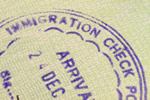Health Risks & Vaccinations In Australia
 Health Risks & Vaccinations In Australia
Health Risks & Vaccinations In Australia
The easiest way for prevention is to see a general practitioner a month to two months before moving to Australia. Emigrants shouldn't wait until they reach Australia to discuss health queries. If people are going to see other countries before settling into their new Australian lifestyle, then it is recommended that they inform their GP about their intended travels too.
Recommended vaccinations
There are rarely any major outbreaks of life-threatening illnesses in Australia, but to be on the safe side, it is recommended that people be up-to-date with their vaccination routines. Some of the main inoculations emigrants should have updated include the measles/mumps/rubella vaccination (MMR), the poliovirus vaccine (usually just two horrific tasting drops under the tongue), and the diphtheria/pertussis/tetanus (DPT) shot. Of course, it is not absolutely essential that these are given prior to arrival in Australia, but they will certainly reduce any unnecessary risks, as Australia has an outdoors culture.
Hepatitis B and Japanese encephalitis are also recommended. Even though not common, rabies is found throughout Australia's natural environments, as there is a large population of bats on the continent. The rabies vaccination is worth while for adventurers, scientists, researchers, and any other person who may come in contact with bats.
Diseases to watch out for
Some of the more infectious diseases located within Australia, even though they are not overly common, include Ross River fever, Murray Valley encephalitis, and Japanese encephalitis. The later disease is primarily found in the northern reaches of Australia. In addition to any vaccinations that could be provided, travellers are able to reduce risks by preventing insect bites. Bugs such as the common mosquito (mozzy) can carry diseases like Ross River fever.
Protect against nature
Vaccinations are only part of the solution when it comes to reducing Australia's health risks. But remember, the land down under is also home to a diverse range of wildlife, some of which are the deadliest species known to man.
Snakes are common place throughout Australia, found in the backyards of inner city homes to the dusty cattle stations of the country's outback. The King Brown and Western Brown are the deadliest snakes found and should be avoided at all costs. Other snakes to avoid include the Red-Bellied Black snake, and sea snakes. Because of the large number of poisonous snakes in Australia, local hospitals generally carry anti-venom for all species.
Snakes are not the only killers to be wary of. Funnel-web spiders, located mainly in New South Wales and southern Queensland, are aggressive and extremely poisonous. Box jellyfish, blue-ringed octopus, stone fish and plenty of shark species make their homes around the Australian coastline. All animals listed have the potential to seriously harm or even kill a person.
Australia has a high-case of skin cancer patients due to the UV strength of the sun in this part of the world. Emigrants must be sun-smart. Getting sunburnt on holiday in Australia may be a novelty for one-timers, but residents must take care of their skin when living in the country. Wear protective clothing as much as possible, and if going outside, apply sunscreen to exposed areas daily.


